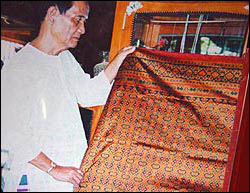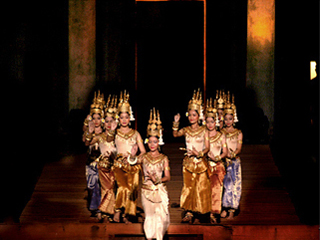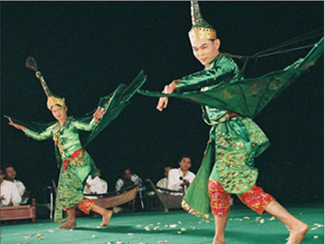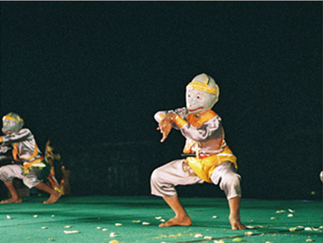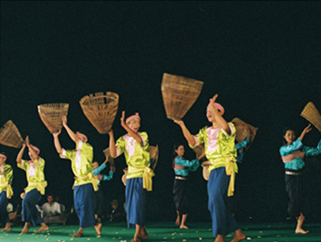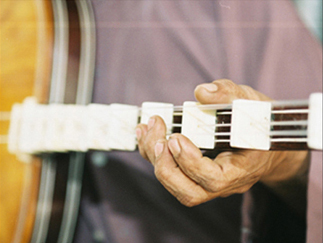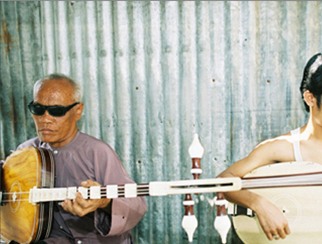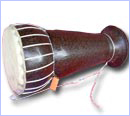"I want younger generations to love Khmer artifacts, to keep them in Cambodia" Liv Saa Em said.
| The lines of culture distinguishing one country from another are blurring. The globalization of technology, information and finance has allowed wealthy countries to export not only their political and economic ideologies to developing countries but their traditions and values as well. The Cambodian government has made aggressive rhetorical efforts to preserve the integrity of traditional Khmer culture, but younger generations are hungry for a change. |
In a seemingly uphill battle to maintain cultural identity in an increasingly homogeneous global community, one man has made it his mission to preserve the past for future generations. From household items and clothes to jewelry and sculpture, Liv Saa Em's private collection is one of the largest in Cambodia. "It is my favorite thing to do since I was young. I like to keep antiques in my house because my parents bought a lot of antiques from villagers to keep at their house. Upon first glance, Liv Saa Em could be mistaken for an ancient Khmer man in his traditional dress. Ancient relics adorn his house as well, stretching from the front door into the darkest corners. The building is his sanctuary; a place Liv Saa Em says keeps him smiling. Visitors to the house, which doubles as a museum, often have offered the collector money for his goods. But Liv Saa Em's mission is to maintain Khmer culture for Cambodia. His message: History is not for sale. The robbery of Khmer artifacts, for sale to foreign countries, is a rising concern. In efforts to preserve the integrity of Cambodia's tangible history, the Ministry of Culture and Fine Arts recently prohibited the exportation of artifacts from Cambodia to Vietnam and Thailand. Liv Saa Em agrees with the act's passage, as he too works to preserve artifacts so that all of Cambodia may enjoy them in years to come. |
| Since the tender age of 13, Liv Saa Em has taken the cue of his parents, who were avid collectors. Now preserving artifacts is not only a hobby--it's a mission. "I'm very upset when I see our artifacts exported to neighboring countries," he said. "We know that they are really Khmer artifacts, but I have no ability to take them back to the country." |
Even when it is not in transit, safeguarding art is not always easy. Liv Saa Em said artifacts kept in the National Museum cannot be promised security, and his house in Tang Yab, Prey Kabas district of Takeo province is no better. Pieces of history were shattered in 1976 when young Khmer Rouge soldiers destroyed his parents' house and the artifacts in it.
Unable to forget the loss, Liv Saa Em has made a conscious effort to buy pieces for his private collection at home. Trading medicine or rice for art, the collector has purchased relics from Takeo, Kampong Speu and Phnom Penh. Now Liv Saa Em's reputation for collecting precedes him, and tourists that visit his home hoping to make a purchase are always denied.
"I love Khmer artifacts and I love to keep them forever," Liv Saa Em said.
"I love Khmer artifacts and I love to keep them forever," Liv Saa Em said.
Liv Saa Em's love affair with the past started when he was just a boy. "I wore simple cloth like other people when I was young," he said. But after completing his studies, Liv Saa Em developed a style of his own. Entering adulthood, he wore the ancient Khmer cloth donned by people of the Funan period and shaved his head so that only a tuft of hair sat atop the middle of his crown.
Businessmen raised Liv Saa Em, the youngest son of a nine-member family that often dressed in traditional Khmer clothing. He was the most beloved of the lot then. Today he is alone. Liv Saa Em's brothers, sisters and parents perished during the war.
Businessmen raised Liv Saa Em, the youngest son of a nine-member family that often dressed in traditional Khmer clothing. He was the most beloved of the lot then. Today he is alone. Liv Saa Em's brothers, sisters and parents perished during the war.
Struggling to overcome the loss of his family, Liv Saa Em filled his time honing his skills as a silk maker. He mixes together a rainbow of colors to produce the vibrant fabric that is exported to Japan today and earned him the Ministry of Culture and Fine Arts' Award for Best Quality Producing in 1993. His Excellency Nut Narang, the former Minister of Culture and Fine Arts, personally recognized Liv Saa Em as the first successful producer of best quality silk following Pol Pot's regime. His creativity is unceasing. Liv Saa Em rearranges the relics in his house to assume a new look every week. In the afternoon visitors can find the collector sitting amidst his artifacts, which he says are a comfort to him. The house, an increasingly popular tourist destination, has drawn curious visitors from around the country and the world. Movie production companies have made the trip as well, using his traditional house for the backdrop to particular scenes.
Liv Saa Em preserves the past to protect the future. Concerned that irresponsible development could damage ancient artifacts, the collector suggested that Cambodia develop a tourism industry based on the riches of Khmer artifacts and temples.
Texts and pictures from Leisure Cambodia.
Khmer Wedding
In Khmer wedding, it has a lot of ceremonies held in chronological orders. They show the historical roots related to the Buddha’s period which existed ages ago. According to a book “Khmer Wedding Rules” of Oknha Nov, it puts that in ancient Khmer wedding laws, people perform a song describing God Vesandor Borom Pothisat arranging the marriage between his children – Chealy and Kroesna. And some other songs are about the marriage arrangement of God Ream and Seda. Oknha Nov wrote that the current wedding preparations are arranged according to the rules drawn up by King Preah Chey Chesda Thebdey. According to the king’s book, it puts that all ceremonies in Khmer wedding are related to mythical stories such as a story “Som Sla Kanseng”. It is told that there were two men who went to feed their buffalos in the field would like to make friends with each other and wanted to be relative by marriage with each other because one had a son and the other had a daughter. In order to prove their words, they ask for betel nuts packed in krama from each other to show their promise that their children would marry to each other. Another story is “the three betel flowers”. It describes that there were four men who had different skills – swimming, shooting, fortune telling, and magic. After completing their study, they returned home. Along the way back near a stream, the fortune teller said that day they were going to meet a girl and become their wife. Then a big bird swooped down on a girl, Khemry, who was having a bath. Right away the shooting man took his bow and shot the bird down back to the stream. The swimmer then swam to bring her to the ground but she was just dead. After that the magic man helped her be alive again. All four men felt in love with the lad, so they were judged by the Buddha that she would become a wife of someone who swam to help her because he was able to touch her body first. And the fortune teller, magic man, and shooting man would become the father, mother, and brother respectively. Since then in all weddings, the bride and the groom must have three betel flowers in order to show gratitude towards their parents and brothers/sisters.
Setting-the-date ceremony and the groom holding the scarf are told that Prince Thaong was married to Princess Tevtey, a daughter of the sea dragon king. After setting the date already, Tevtey had to bring him to her father at dragon world, so the sea dragon’s daughter asked the prince to hold her scarf in order to dive into the dragon world. In the meanwhile, the dragon king commanded his man to kill the prince at the gate in order to test the prince’s ability. But the daughter had known this; hence, she disguised herself as the prince by changing her skirt and it was put on the prince instead so that the killer was not able to kill the prince. That is why in the current Khmer wedding it was seen that there is clothes change between the groom and the bride, and the groom holding the bride’s scarf in to the room, accompanied by “Phat Cheay and Neang Neak” songs, etc. The ceremony called “Chey Haong Sousdey Haong Men Haong” in wedding ceremony performed until now is followed by an ancient story recorded in “the rules of wedding” book. It describes that Once upon a time there were two brothers – Chey and Sousdey. At that time, there was no king to continue after the previous king had died in Cambodia, so the officials in the palace relied on the holy elephant and horse to find a man to be their king. Then the animals approached the brothers’ house. Consequently, they knew that one of the brothers was the suitable man to be crowned. Chey became the king and Sousdey became his assistant at the same time. When crowned, the people whooped to bless the king. They said “Chey Haong Sousdey Haong Men Haong” simultaneously. The blessing is adapted to use in the wedding until now. “Bongvil Popil” ceremony in the Khmer wedding is also written in “collective Khmer legends” book, volume 9. According to the legend, it is told that once upon a time, there was a man named Chey Sorya who had completed the magic training already from Eyso God, so he asked the God for a sacred relic as a blessing tool for the weddings of human being. Then the God gave the man a replica of his penis and a replica of his wife’s vagina as the blessing tools to spread their reputation in the world. Eyso God took diamond sand from the universe to make a gold banyan leaf representing his wife’s vagina and took a diamond rock from Himalaya Mountain to make a candle representing his penis and supposed them to be “two blessings”. He then told the man to take the candle wrapped in the banyan leaf to circle three times around grooms and brides in order to inhale the smoke making them powerful. The “Popil” ceremony is believed to bring harmony and joyfulness for the new couples making them successful in all challenges. Since Khmer people firmly and sincerely believe in “Popil”, it is performed not only in wedding ceremony but also in other ceremonies such as housewarming, birthday, etc. “holding a sword” tradition in the wedding progress is also told that once upon a time there was a high ranking knight in Peareansey Palace, who fell in love with a daughter of the villager and deposit a piece of gold as a dowry and promised to marry in three months’ time. Three years had gone, so she was married to her neighbor villager but on the wedding day, the knight appeared and took out his sword and killed the man who was the groom. Then the chief clergyman had prayed to dismiss all bad things at the place. The clergyman had analyzed on the power of the sword. That is why people use a sword in the wedding when the bride and the groom are in pair for blessing.
According to Mr. Nhean Phoeun, a researcher and publisher of Khmer tradition of national and international festival committee, he said that Khmer tradition allows people to marry only in a period of six months in a year but not the other six. Wedding can be carried out only in the 30-day months. Those six months could be in early May, July, October, January, and March. But for engagement ceremony and matching the natural chemistry between son and daughter, they could be performed in any month. He continued that for the above months, there are only 7 days of each month that are good days. According to the Khmer tradition, they should not perform on their birthday, religious day, lunar or and solar eclipse, and during Khmer new years. Actually, the reason people do not get married in the rain season is that there are a lot of rains that make it difficult for the wedding reception, procession, and other ceremonies. It is also difficult for the guests travelling to wedding party and it is when farmers are busy with their fields. |
Khmer Dance
Classical Dance of Cambodia The epic poem of Rama (Ramayana) is believed to have been revealed to a Hindu holy man named Valmiki by Brahma, the god of creation. This religious literary work, dating from about ad 4, is known in various versions throughout India and Southeast Asia. In Cambodia, the story has been set to music and dance and performed by the Royal Ballet since the 18th century. Although the epic is also known in the villages, where it is translated orally or dramatized in the popular shadow puppet theater, the ballet was traditionally a courtly art performed in the palace or for princely festivals. The music of the ballet is performed by the Pinpeat orchestra, which is made up of traditional xylophones, metallophones, horizontal gongs, drums, and cymbals | ||||||||
| ||||||||
|
|

